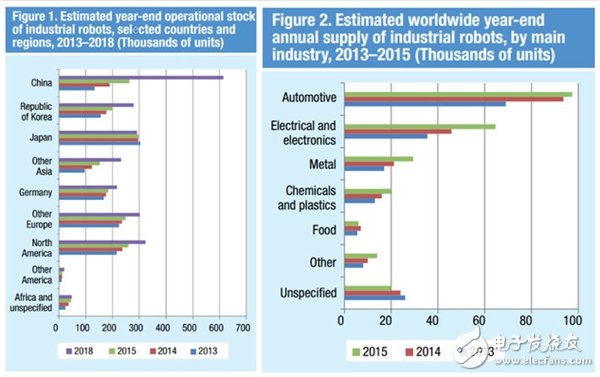The United Nations recently released a report saying that there is a phenomenon of “premature industrialization†on a global scale. In developing countries, two-thirds of the labor force will be replaced by robots.
In the report, the United Nations pointed out that industrial robots are mainly used in the automotive, electronics and electrical industries. This means that Mexico, which relies on the above-mentioned industries in the export sector, and many Asian developing countries will face enormous risks. On the contrary, in many labor-intensive industries such as garments, it is not appropriate to implement automation on a large scale. Therefore, for countries with employment concentrated in low-skilled labor, such as most parts of Africa, the application of robots under the current cost structure will instead Push up production costs.
The following chart shows the stock of industrial robots in major countries and regions from 2013 to 2018 and the supply of robots in major industries from 2013 to 2015.

(Image from UN report)
It is worth noting that since 2013, China has purchased more industrial robots per year than other countries. By the end of 2016 or beyond Japan, it has become the world's largest industrial robot user. Although the density is not as high as that of Germany, Japan, and South Korea, the rhythm of using robots in production may ease the erosion of China's competitive advantage in labor-intensive manufacturing.
In addition, jobs created by robots are often concentrated in high-skilled production activities, while low-skilled workers enjoy relatively little benefit.
The financial impact of robotic employment remains questionable. Obviously, if a large amount of tax is not imposed on robots, the robot-based manufacturing industry will not be able to contribute to the financial revenues of social transfer payments, thus failing to compensate workers who are unemployed due to robots, nor can they pay the minimum wage to prevent the lives of low- and medium-skilled workers. The level drops.
It is not just the United Nations that realizes that “premature industrialization†poses risks.
The World Bank pointed out in its report that developing countries are encouraged to adopt radical digital technologies and “supportive macroeconomic, industrial and social policies†in response to such “destructive technologiesâ€.
Wall Street’s observations have previously quoted US VOX website columnist Matthew Yglesias as saying that the trend toward automation is painful for workers in countries at any stage of economic development, for those developing in the hope of manufacturing to drive economic growth. This is especially true for the country.
Earlier this year, the Financial Times quoted research from Martin College and Citibank of Oxford University as saying that countries such as Nepal, Cambodia, China, Bangladesh and Guatemala face the most serious “premature industrialization†risks. The proportion of jobs in India and China that are facing “high-risk†automation is 69% and 77%, respectively, which is much higher than 47% in the US. Ethiopia’s high-risk jobs even account for 85%.
The above research suggests that as robots replace human workers, low-income countries will lose the advantage of labor costs in more and more industries, which is comparable to the cost of high-wage countries.
P04 Series Push Wire Connectors
compact universal lever connector, perfect for tight spaces
transparent housing for visual inspection of connection
reusable
Lever Nut Wire Connector,Transparent Enclosure Terminal Blocks,5 Poles Push Wire Connectors,Building Technology Wire Connectors
Jiangmen Krealux Electrical Appliances Co.,Ltd. , https://www.krealux-online.com